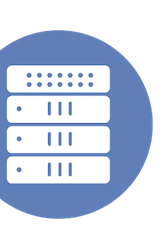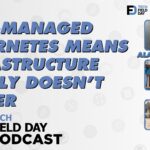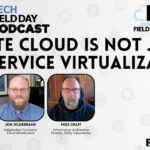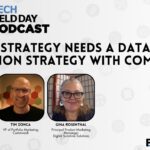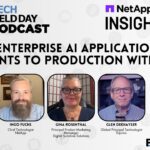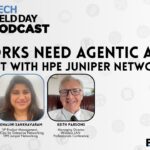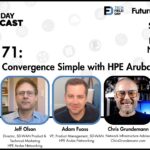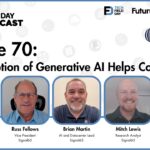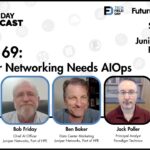2025 was the year of AI Mania. Everyone wants you to know where they stand with AI in their product. Tech Field Day has a different approach. In this special year end episode, Tom Hollingsworth, Stephen Foskett, and Alastair Cooke look back at the discussions and deep dives into AI and how Tech Field Day grounded them all in practical real terms. Our event leads discuss the boring reality of AI tools and how AI has a dual nature that must be understood to get real value. They also debate the changing landscape of security where AI is concerned, including the importance of data sovereignty. They wrap up with a focus on the fundamentals and how Tech Field Day continues to make those important for the community at large.
Generative AI Coding Tools Make Enterprise Applications Worse
AI is writing a large proportion of modern software and Generative AI coding tools make enterprise applications worse. This episode of the Tech Field Day podcast looks at AI generated applications with Calvin Hendryx-Parker, Jim Czuprynski, Jay Cuthrell, and Alastair Cooke. Satya Nadella says that up to 30% of the code Microsoft writes is AI generated, AWS is at about 25% AI generated code. We ponder whether there is a link between this AI generated code and the quality of the Windows 11 codebase, possibly even the recent AWS outage? Calvin has hands-on experience with a range of AI coding tools, finding he uses different AI tools for specialist tasks in his development projects. The easy task for AI coding is translating existing applications from one platform version to another, or rewriting existing application code in new languages. Both these tasks are onerous for human developers and ideal for an AI assistant. The unanswered question is whether generative AI tools can handle creating new functionality in enterprise applications, can AI fulfill the role of the senior developer or software architect?
DNS Must Be Secured Presented by Infoblox
DNS security is no longer optional. This service is not only being attacked by nefarious actors but it is also being leveraged in ways to compromise users and exfiltrate data. In this episode of the Tech Field Day podcast, brought to you by Infoblox, Tom Hollingsworth is joined by Jack Poller and Cricket Liu. They talk about the historical openness of DNS and how that has led to it becoming easy to see what users are doing and create ways to manipulate them. They discuss ways to secure the protocol and how companies like Infoblox are extending the capabilities for future security.
Well Managed Kubernetes Means Infrastructure Finally Doesn’t Matter
In a world of well-managed Kubernetes, we hoped that infrastructure finally wouldn’t matter. This episode of the Tech Field Day podcast features John Willis and Guy Currier wishing that infrastructure didn’t matter, with Alastair Cooke. Every new infrastructure revolution claims to make infrastructure invisible, from virtualization through HCI and cloud to containers and Kubernetes. The reality has always been that these revolutions shift the definition of infrastructure and bring some new aspect to be managed. Developers building features and applications want to focus on satisfying some business need, not considering storage devices and network configurations. Virtualization and Kubernetes both made delivering infrastructure easier, but neither eliminated infrastructure architecture and management. The dream of self-deploying and self-organizing infrastructure is as distant as it ever was. Agentic AI is the latest new hope to eliminate infrastructure challenges, yet it brings its own complex infrastructure requirements. Will we ever stop caring about IT infrastructure?
Private Cloud is Not just Self-Service Virtualization
Private cloud is not just virtualization 4.0, self-service VM deployment doesn’t fulfil the same need as the Public Cloud. This episode of the Tech Field Day podcast features Mike Graff, Jon Hildebrand, and Alastair Cooke. Private cloud has evolved from simple virtualization to a more comprehensive, cloud-like experience, emphasizing the need for on-premises infrastructure to offer the same developer-friendly tools and APIs as public clouds. Some application repatriation is driven by cost concerns and enabled by rise of technologies like Kubernetes and OpenShift for managing containerized workloads. A unified control plane for hybrid cloud environments is vital, as is accurate cost accounting for on-premises resources. Enterprises will search for a hybrid approach where developers can deploy applications without needing to worry about the underlying infrastructure.
Your Edge Projects will Fail Without Fleet Lifecycle Management with ZEDEDA
Projects to deliver applications to edge locations will fail without comprehensive fleet lifecycle management. This episode of the Tech Field Day podcast features Sachin Vasudeva from Zededa discussing the importance of long-term edge management with Guy Currier and Alastair Cooke. There are unique challenges of managing edge deployments compared to cloud or on-premises environments. Focusing on business logic and application outputs while leveraging infrastructure providers to handle the complexities of packaging, deploying, and monitoring AI models enables diverse edge environments. Edge locations might have different hardware deployed, intermittent connectivity, requiring a balance between standardization and flexibility in managing edge devices and applications. Teams with rapid responsiveness and adaptation will better enable their business to respond to changing conditions, especially with the rapid pace of AI innovation.
Every AI Strategy Needs a Data Protection Strategy with Commvault
Every company lives in fear of a ransomware attack, whether they have suffered one or not, and this is even more critical in the era of AI. This episode of the Tech Field Day Podcast looks forward to Commvault SHIFT in November with a discussion of the importance of data protection to AI applications with Tim Zonca from Commvault, frequent delegate Gina Rosenthal, and host Stephen Foskett. AI applications are reliant on good data, and yet this same technology makes it easier for attackers to breach corporate controls. Today’s social engineering and phishing is more convincing than ever thanks to generative AI, and this has helped ransomware crews to adopt larger and more powerful attacks. Ransomware is a massive business, and it isn’t going away any time soon. At the same time, GenAI applications offer a new attack surface, as agentic AI is empowered to take action based on untrusted inputs. Not only can we not stop ransomware, but the pace and technical capabilities of these attacks keeps accelerating. There is reason for optimism, however, as data protection tools keep getting better. Today’s AI-optimized tools can effectively categorize data, burst or migrate to different locations, and roll back or recover from corruption or compromise. In the future, we will see increasing use of AI to monitor systems and data, detecting patterns and hardening the attack surface.
Moving Enterprise AI Applications From Experiments to Production with NetApp
Running enterprise applications in production is a lot different from the AI experiments many of us have been involved with so far. This episode of the Tech Field Day podcast, recorded prior to NetApp Insight 2025, features Ingo Fuchs from NetApp along with Gina Rosenthal, Glenn Dekhayser, and Stephen Foskett. AI applications often start as experiments with a limited data set, but once these are moved to production there are many critical decisions to be made. Data must be classified and cleaned, removing personal and financial data and proprietary information before it even reaches an LLM. Data also must be structured for embedding and vectorization prior to use by an LLM. And we have to ensure that data is up to date or the application will not serve the customer properly. Finally we have to consider whether it is proper and ethical to share and act on this data. Many of the challenges facing modern AI applications are similar to the historic issues faced by enterprise storage, and this is an area in which NetApp and their customers have decades of experience.
Passkeys are the Future
Passwords create friction and therefore users find ways around them. New technology such as secure enclaves and PKI allow us to create better solutions like passkeys. In this episode of the Tech Field Day Podcast. Alan Shimel and Kate Scarcella join Tom Hollingsworth to discuss the problems with traditional passwords and how passkeys overcome them. They also talk about why it has taken so long to adopt passkeys and what barriers remain to full implementation. The wrap up with a look at what might lay ahead on the horizon for the future of user security.
Unified Flash Memory and Reduced HBM are Reshaping AI Training and Inference with Phison
AI will need less HBM (high bandwidth memory) because flash memory unification is changing training and inference. This episode of the Tech Field Day podcast features Sebastien Jean from Phison, Max Mortillaro, Brian Martin, and Alastair Cooke. Training, fine-tuning, and inference with Large Language Models traditionally use GPUs with high bandwidth memory to hold entire data models and data sets. Phison’s aiDaptiv+ framework offers the ability to trade lower cost of infrastructure against training speed or allow larger data sets (context) for inference. This approach enables users to balance cost, compute, and memory needs, making larger models accessible without requiring top-of-the-line GPUs, and giving smaller companies more access to generative AI.
Networks Need Agentic AI with HPE Juniper Networking
Agentic AI is reshaping the IT landscape and networking is no exception. Building upon the previous research into machine learning means we have a head start on harnessing that power. In this episode of the Tech Field Day podcast, brought to you by HPE Juniper Networking, Tom Hollingsworth is joined by Keith Parsons and Sunalini Sankhavaram. They talk about how agentic AI is driving new methods for operating networks and helping humans concentrate on real problems instead of menial tasks. They also discuss how agentic AI can power self-driving networks where configuration and provisioning are done automatically or with a minimum of effort to ensure resiliency and enhance user expectations.
SASE Makes Convergence Simple with HPE Aruba Networking
Converged networking is creating complexity with network operations and engineering teams. Ensuring that users are able to access resources and complete workflows means being up-to-date with the latest technology behind the scenes. You need a trusted partner to make it all happen with minimal issues.
In this episode of the Tech Field Day Podcast, brought to you by HPE Aruba Networking, Tom Hollingsworth is joined by Chris Grundemann, Jeff Olson, and Adam Fuoss as they discuss the growing challenges with networking and how HPE Aruba Networking is addressing them. They talk about SASE and SSE and how tools such as Cloud-Native NAC and SASE AI Copilot work together to address the needs of the modern network. These features, debuted at Black Hat 2025, help teams by making sense of the network and keeping it secure from intruders.
They discuss how AI is going to accelerate operations teams while providing context and understanding for challenges. They also talk about how cloud native principles an apply to both online and on-prem configurations. The panel wraps up with a discussion of the importance of a sole-source provider for these solutions and how HPE Aruba Networking is addressing the integration of recent acquisitions.
Early Adoption of Generative AI Helps Control Costs with Signal65
If you haven’t already, start working with Generative AI now and make sure to control your ongoing costs. This episode of the Tech Field Day podcast features Russ Fellows, Mitch Lewis, and Brian Martin, all from Signal65, and is hosted by Alastair Cooke. Generative AI is delivering value to businesses of all sizes, but significant evolution in models and technologies remains before maturity is achieved. Experimentation is essential to understand the value of new technologies, starting with cloud resources or small-scale on-premises servers. Business value is derived from the inference stage, where AI tools generate actionable information for users. Generative AI is like a knowledgeable and well-intentioned intern; someone more senior must ensure AI is given good instructions and check their work. In production, grounding and guard rails are vital to keep your AI an asset, not a liability.
Datacenter Networking Needs AIOps with HPE Juniper Networks
Enterprise networking is too large and complex, we need AI Operations. This spotlight episode of the Tech Field Day podcast features Bob Friday and Ben Baker, both from Juniper Networks, with Jack Poller and Alastair Cooke. Modern enterprise networks reach far beyond the well-controlled walls of data centres and corporate buildings. The rate of change enabled by public cloud platforms makes an enterprise network highly dynamic. Access to cloud and on-premises applications over the Internet means your users are dependent on many network elements outside of your control. Bob founded Mist Networks to help businesses manage the complexity of user-to-cloud networking. Juniper Networks acquired Mist, and now HPE has acquired Juniper. I don’t think he is alone in seeing the necessity of using AI to manage complex and critical networks. Yet new tools always bring new challenges; the cost of AI infrastructure may be a concern, and Generative AI has challenges with hallucinations. The security and governance practices around AI tools are still developing, and the non-deterministic nature of AI needs careful consideration.
Network Engineers are Facing an Identity Crisis
Network engineers are the firefighters and knowledge bases of enterprise IT, however the role of a network engineer is rapidly evolving. With the rise of automation, orchestration, and AI, the familiar image of an engineer hunched over a command-line interface (CLI) is giving way, leading many to question the future of their profession. In this episode, Tom Hollingsworth is joined by Ryan Harris, Chris Grundemann, and Nathan Nielsen as they discuss how the perception of their role has shifted, the continuous need for learning and adaptation, and whether the CLI is truly dead.
The conversation explores the challenges and opportunities presented by these technological advancements, highlighting how network engineers are embracing new tools like chatbots and GUIs for enhanced visualization. While some aspects of the job, like manual CLI work, may be diminishing, the core principles of understanding network functionality remain core to the role of the network engineer. The panel talks about identity crisis in a field where continuous learning is essential, contrasting it with professions like doctors and lawyers who deal with slower-changing fundamentals. They discuss the value of specialization versus being a generalist, the concept of the “pitchfork engineer,” and ultimately, how redefining their identity as lifelong learners can help network engineers thrive in this ever-changing landscape.
Re-Imagining the Mainframe for the AI Era at SHARE
As Tech Field Day heads to SHARE in Cleveland, we are considering the many ways the mainframe has been re-imagined and re-built for the AI era. This episode of the Tech Field Day podcast features Cynthia Overby of Rocket Software and SHARE, Derek Britton, and Jeffrey Powers discussing the modern mainframe with Stephen Foskett. Walk around the SHARE conference and you’ll see the same concepts and technologies that you would find at any other conference: AI, security, data management, software development, and connectivity. Although the mainframe platform is radically different from the so-called open systems used in the cloud and elsewhere, IBM has re-engineered the new z17 mainframe for the AI age. The mainframe hosts the most valuable data in the world, and if AI is going to be used it has to run locally. That’s why IBM added a second-generation AI accelerator to the latest Telum II processor, the Spyre Accelerator, and z/OS itself. We’re excited to be bringing Tech Field Day to SHARE to learn more about the modern mainframe and share the state of the art with our audience.
The DoJ Just Devalued Juniper Mist
The proposed remedies for the HPE acquisition of Juniper Networks did a real disservice to Juniper Mist. The confusion around what’s going on with the proposed Juniper AIOps for Mist auction have professionals asking a lot of questions. In this episode, recorded on the eve of the close of the acquisition, Tom Hollingsworth sits down with Sam Clements, Jake Snyder, and Ed Weadon to make sense of it all. There are discussions about what exactly is included in the auction and what benefit will come from the license to use Juniper AIOps for Mist. Also discussed is who might be a good bidder for the solution and how long it will take for them to get any real value from it.
Enterprises Shouldn’t Be Outsourcing Their IT Anymore
Enterprise networks are complicated but outsourcing all of the operations team doesn’t lead to better outcomes. It’s important to remember that enterprise covers a wide range of network definitions. In this episode, Ed Weadon, Chris Grundemann, and Jody Lemoine join Tom Hollingsworth as they discuss how businesses see the network and IT in general as a cost center instead of value generation. They also talk about the various sizes of networks and why each of them has issues with the most popular outsourcing methods. They also discuss the human factor and why not all managed providers can give you the same level of service.







